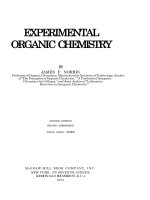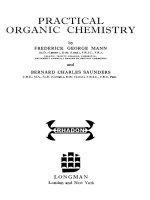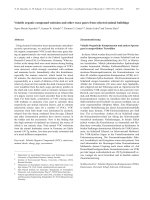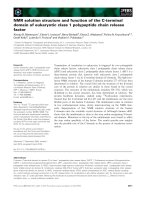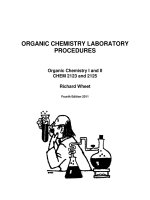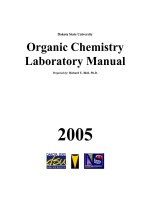K peter c vollhardt, neil e schore organic chemistry structure and function w h freeman (2014)
Bạn đang xem bản rút gọn của tài liệu. Xem và tải ngay bản đầy đủ của tài liệu tại đây (29.8 MB, 1,351 trang )
Periodic Table of the Elements
1
Relative atomic mass (atomic weight), 2013 IUPAC values; the IUPAC recommends atomic
weight ranges for several elements but approves single “convenience” values for those elements
as well; these values are used in the Table
* for these radioactive elements, nuclidic mass of an important isotope
1.008
1, Ϫ1
1
2.2
1
H
Oxidation states in compounds:
important, most important
2
6.94
9.0121831
1
2
2
1.0
55.845
6, 3, 2, 0, Ϫ2
1.8
Electronegativity
26 Fe
1.6
Atomic number
3
Li
4
Be
22.989770
24.305
1
2
3
Element essential to at least one
biological species
1.3
0.9
11 Na
Element essential to
all biological species investigated
12 Mg
3
4
5
6
7
8
9
39.0983
40.078
44.955908
47.867
50.9415
51.9961
54.938044
1
2
3
4, 3
5, 4, 3, 2, 0
6, 3, 2, 0
7, 6, 4, 3, 2, 0, Ϫ1 6, 3, 2, 0, Ϫ2
4
0.8
1.0
1.4
1.5
1.6
1.7
20 Ca
21 Sc
22
85.4678
87.62
88.90584
91.224
92.90637
95.95
1
2
3
4
5, 3
6, 5, 4, 3, 2, 0
19
K
5
0.8
37 Rb
1
Sr
180.94788
183.84
4
5
6, 5, 4, 3, 2, 0
223.0197*
226.0254*
1
2
0.8
1.8
1.9
26 Fe
27 Co
98.9063*
101.07
102.90550
7
8, 6, 4, 3, 2, 0, Ϫ2 5, 4, 3, 2, 1, 0
2.3
44 Ru
45 Rh
186.207
190.23
192.217
7, 6, 4, 2, Ϫ1
8, 6, 4, 3, 2, 0, Ϫ2 6, 4, 3, 2, 1, 0, Ϫ1
43
Tc
2.4
2.2
72 Hf
73 Ta
74 W
75 Re
76 Os
77
267.12*
268.13*
271.13*
270.13*
277.15*
278.16*
Ac–Lr
104 Rf
105 Db
106 Sg
107 Bh
108 Hs
109 Mt
138.90547
140.116
140.90766
144.242
146.9151*
150.36
151.964
3
4, 3
4, 3
3
3
3, 2
La–Lu
0.9
42 Mo
1.3
57 to 71
3, 2, 0, Ϫ1
2.2
178.49
56 Ba
Fr
1.3
58.933194
1.6
25 Mn
2
0.9
Y
24 Cr
137.327
39
55 Cs
87
1.2
V
41 Nb
0.8
7
23
40 Zr
38
132.9054520
6
1.0
Ti
55.845
Ir
89 to 103
88 Ra
Lanthanides
1.1
1.1
1.1
1.1
1.2
3, 2
1.2
1.2
57 La
58 Ce
59 Pr
60 Nd
61 Pm
62 Sm
63 Eu
227.0278*
232.0377
231.03588
238.02891
237.0482*
244.0642*
243.0614*
3
4
5, 4
6, 5, 4, 3
6, 5, 4, 3
6, 5, 4, 3
6, 5, 4, 3
Actinides
1.2
89 Ac
1.3
90 Th
1.3
91 Pa
1.4
92
U
1.4
93 Np
1.3
94 Pu
95 Am
18
4.002602
13
s Block elements
d Block elements
p Block elements
f Block elements
14
10.81
12.011
3
4, 2, Ϫ4
15
14.007
5, 4, 3, 2, Ϫ3
2.0
5
2.6
B
6
26.9815385
28.085
3
4, Ϫ4
7
11
12
30.97376200
1.9
13 Al
14
Si
58.6934
63.546
65.38
69.723
72.630
2, 1
2
3
4
1.7
1.9
30 Zn
31 Ga
107.8682
112.414
2, 1
2
28 Ni
29 Cu
106.42
4, 2, 0
1.9
2.2
46 Pd
47 Ag
195.084
4, 2, 0
118.710
121.760
3
4, 2
5, 3, Ϫ3
1.8
196.966569
200.592
3, 1
2, 1
F
9
10 Ne
32.06
35.45
6, 4, 2, Ϫ2
7, 5, 3, 1, Ϫ1
39.948
2.6
S
3.2
17
Cl
18 Ar
78.971
79.904
6, 4, Ϫ2
7, 5, 3, 1, Ϫ1
83.798
2.6
34 Se
2.0
4.0
O
2.2
114.818
49
2.5
2.0
33 As
1.7
3.4
16
5, 3, Ϫ3
32 Ge
48 Cd
2.3
P
74.921595
1.8
18.99840316 20.1797
Ϫ1
2.2
15
He
15.999
8
5, 3, Ϫ3
3, 2, 0
1.9
N
2
17
Ϫ2, Ϫ1
3.0
C
1.6
10
16
2
3.0
3.0
35 Br
36 Kr
127.60
126.90447
131.293
6, 4, Ϫ2
7, 5, 1, Ϫ1
8, 6, 4, 2
2.1
2.1
51 Sb
52
204.38
207.2
208.98040
208.9824*
209.9871*
222.0176*
3, 1
4, 2
5, 3
6, 4, 2
7, 5, 3, 1, Ϫ1
2
2.0
2.3
2.0
2.0
53
I
2.6
50 Sn
In
Te
2.7
54 Xe
2.0
Pt
79 Au
80 Hg
81 Tl
82 Pb
83 Bi
84 Po
85 At
86 Rn
281.17*
282.17*
285.18*
285.18*
289.19*
289.19*
293.2*
294.21*
294.21*
110 Ds
111 Rg
112 Cn
157.25
158.92535
162.500
164.93033
167.259
168.93422
173.054
174.9668
3
4, 3
3
3
3
3, 2
3, 2
3
78
1.2
1.2
113 Uut
114 Fl
1.2
1.2
1.2
64 Gd
65 Tb
66 Dy
67 Ho
68
247.0704*
247.0703*
251.0796*
252.083*
4, 3
4, 3
4, 3
3
96 Cm
97 Bk
98
Cf
99
Es
115 Uup
Er
116 Lv
117 Uus
1.3
1.0
69 Tm
70 Yb
71 Lu
257.0951*
258.0984*
259.101*
262.11*
3
3
3, 2
3
100 Fm
101 Md
102 No
103 Lr
118 Uuo
O RG A N I C C HE MISTRY
About the Authors
K. PETER C. VOLLHARDT was born in Madrid, raised in Buenos Aires and Munich,
studied at the University of Munich, got his Ph.D. with Professor Peter Garratt at
the University College, London, and was a postdoctoral fellow with Professor Bob
Bergman (then) at the California Institute of Technology. He moved to Berkeley in
1974 when he began his efforts toward the development of organocobalt reagents
in organic synthesis, the preparation of theoretically interesting hydrocarbons, the
assembly of novel transition metal arrays with potential in catalysis, and the discovery of a parking space. Among other pleasant experiences, he was a Studienstiftler,
Adolf Windaus medalist, Humboldt Senior Scientist, ACS Organometallic Awardee,
Otto Bayer Prize Awardee, A. C. Cope Scholar, Japan Society for the Promotion of
Science Prize Holder, and recipient of the Medal of the University Aix-Marseille
and an Honorary Doctorate from The University of Rome Tor Vergata. He is the
current Chief Editor of Synlett. Among his more than
350 publications, he treasures especially this textbook
in organic chemistry, translated into 13 languages.
Peter is married to Marie-José Sat, a French artist, and
they have two children, Paloma (b. 1994) and Julien
(b. 1997), whose picture you can admire on p. 168.
NEIL E. SCHORE was born in Newark, New Jersey,
in 1948. His education took him through the public
school of the Bronx, New York, and Ridgefield, New
Jersey, after which he completed a B.A. with honors in
chemistry at the University of Phennsylvania in 1969.
Moving back to New York, he worked with the late
Professor Nicholas J. Turro at Columbia University,
studying photochemical and photophysical processes
of organic compounds for his Ph.D. thesis. He first met Peter Vollhardt when he and
Peter were doing postdoctoral work in Professor Robert Bergman’s laboratory at Cal
Tech in the 1970s. Since joining the U.C. Davis faculty in 1976, he has taught organic
chemistry to more than 15,000 nonchemistry majors, winning seven teaching awards,
publishing over 100 papers in various areas related to organic chemistry, and refereeing several hundred local youth soccer games. Neil is married to Carrie Erickson, a
microbiologist at the U.C. Davis School of Veterinary Medicine. They have two
children, Michael (b. 1981) and Stefanie (b. 1983), both of whom carried out experiments for this book.
ORGANIC CHEMISTRY
Structure and Function
PETER VOLLHARDT
University of California at Berkeley
NEIL SCHORE
University of California at Davis
W.H. Freeman and Company
A Macmillan Higher Education Company
SEVENTH EDITION
Publisher: Jessica Fiorillo
Acquisitions Editor: Bill Minick
Development Editor: Randi Blatt Rossignol
Marketing Manager: Debbie Clare
Media and Supplements Editor: Dave Quinn
Assistant Editor: Nick Ciani
Photo Editor: Robin Fadool
Photo Assistant: Eileen Liang
Photo Researcher: Dena Digilio Betz
Cover Designer: Blake Logan
Text Designer: Patrice Sheridan
Project Editing and Composition: Aptara®, Inc.
Illustrations: Network Graphics; Precision Graphics
Illustration Coordinator: Dennis Free at Aptara®, Inc.
Production Coordinator: Susan Wein
Printing and Binding: RR Donnelley
Library of Congress Control Number: 2013948560
ISBN-13: 978-1-4641-2027-5
ISBN-10: 1-4641-2027-7
© 2003, 2007, 2011, and 2014 by W. H. Freeman and Company
All rights reserved
Printed in the United States of America
First printing
W. H. Freeman and Company
41 Madison Avenue
New York, NY 10010
Houndmills, Basingstoke RG21 6XS, England
www.whfreeman.com
BRIEF CONTENTS
PREFACE: A User’s Guide to ORGANIC CHEMISTRY:
Structure and Function
1 STRUCTURE AND BONDING IN ORGANIC MOLECULES
xxv
1
2 STRUCTURE AND REACTIVITY
Acids and Bases, Polar and Nonpolar Molecules
49
3 REACTIONS OF ALKANES
Bond-Dissociation Energies, Radical Halogenation,
and Relative Reactivity
97
4 CYCLOALKANES
131
5 STEREOISOMERS
167
6 PROPERTIES AND REACTIONS OF HALOALKANES
Bimolecular Nucleophilic Substitution
211
7 FURTHER REACTIONS OF HALOALKANES
Unimolecular Substitution and Pathways of Elimination
247
8 HYDROXY FUNCTIONAL GROUP: ALCOHOLS
Properties, Preparation, and Strategy of Synthesis
279
9 FURTHER REACTIONS OF ALCOHOLS
AND THE CHEMISTRY OF ETHERS
325
10 USING NUCLEAR MAGNETIC RESONANCE
SPECTROSCOPY TO DEDUCE STRUCTURE
377
vi
Brief Contents
11 ALKENES: INFRARED SPECTROSCOPY
AND MASS SPECTROMETRY
433
12 REACTIONS OF ALKENES
483
13 ALKYNES
The Carbon–Carbon Triple Bond
541
14 DELOCALIZED PI SYSTEMS
Investigation by Ultraviolet and Visible Spectroscopy
579
INTERLUDE: A Summary of Organic Reaction Mechanisms
635
15 BENZENE AND AROMATICITY
Electrophilic Aromatic Substitution
641
16 ELECTROPHILIC ATTACK ON DERIVATIVES OF BENZENE
Substituents Control Regioselectivity
695
17 ALDEHYDES AND KETONES
The Carbonyl Group
737
18 ENOLS, ENOLATES, AND THE ALDOL CONDENSATION
␣,-Unsaturated Aldehydes and Ketones
789
19 CARBOXYLIC ACIDS
833
20 CARBOXYLIC ACID DERIVATIVES
885
21 AMINES AND THEIR DERIVATIVES
Functional Groups Containing Nitrogen
933
22 CHEMISTRY OF BENZENE SUBSTITUENTS
Alkylbenzenes, Phenols, and Benzenamines
979
23 ESTER ENOLATES AND THE CLAISEN CONDENSATION
Synthesis of -Dicarbonyl Compounds;
Acyl Anion Equivalents
1039
Brief Contents
24 CARBOHYDRATES
Polyfunctional Compounds in Nature
1073
25 HETEROCYCLES
Heteroatoms in Cyclic Organic Compounds
1121
26 AMINO ACIDS, PEPTIDES, PROTEINS, AND NUCLEIC ACIDS
Nitrogen-Containing Polymers in Nature
Answers to Exercises
Photograph Credits
Index
1165
A-1
C-1
I-1
vii
CONTENTS
PREFACE: A User’s Guide to ORGANIC CHEMISTRY:
Structure and Function
1 STRUCTURE AND BONDING IN ORGANIC MOLECULES
The Scope of Organic Chemistry: An Overview
Real Life: Nature 1-1 Urea: From Urine to Wöhler’s Synthesis
to Industrial Fertilizer
1-2
Coulomb Forces: A Simplified View of Bonding
1-3
Ionic and Covalent Bonds: The Octet Rule
1-4
Electron-Dot Model of Bonding: Lewis Structures
1-5
Resonance Forms
1-6
Atomic Orbitals: A Quantum Mechanical Description
of Electrons Around the Nucleus
1-7
Molecular Orbitals and Covalent Bonding
1-8
Hybrid Orbitals: Bonding in Complex Molecules
1-9
Structures and Formulas of Organic Molecules
Worked Examples: Integrating the Concepts
Important Concepts
Problems
xxv
1
2
1-1
4
5
7
13
18
23
28
31
37
40
44
45
2 STRUCTURE AND REACTIVITY
Acids and Bases, Polar and Nonpolar Molecules
49
Kinetics and Thermodynamics of Simple
Chemical Processes
50
2-2
Keys to Success: Using Curved “Electron-Pushing”
Arrows to Describe Chemical Reactions
57
2-3
Acids and Bases
60
Real Life: Medicine 2-1 Stomach Acid, Peptic Ulcers, Pharmacology,
and Organic Chemistry
61
2-4
Functional Groups: Centers of Reactivity
69
2-5
Straight-Chain and Branched Alkanes
72
2-6
Naming the Alkanes
73
2-7
Structural and Physical Properties of Alkanes
78
Real Life: Nature 2-2 “Sexual Swindle” by Means of
Chemical Mimicry
81
2-8
Rotation About Single Bonds: Conformations
81
2-9
Rotation in Substituted Ethanes
84
2-1
x
Contents
Worked Examples: Integrating the Concepts
Important Concepts
Problems
88
91
92
3 REACTIONS OF ALKANES
Bond-Dissociation Energies, Radical Halogenation,
and Relative Reactivity
Strength of Alkane Bonds: Radicals
Structure of Alkyl Radicals: Hyperconjugation
Conversion of Petroleum: Pyrolysis
Real Life: Sustainability 3-1 Sustainability and the Needs
of the 21st Century: “Green” Chemistry
3-4
Chlorination of Methane: The Radical Chain Mechanism
3-5
Other Radical Halogenations of Methane
3-6
Keys to Success: Using the “Known” Mechanism
as a Model for the “Unknown”
3-7
Chlorination of Higher Alkanes: Relative Reactivity
and Selectivity
3-8
Selectivity in Radical Halogenation with Fluorine
and Bromine
3-9
Synthetic Radical Halogenation
Real Life: Medicine 3-2 Chlorination, Chloral, and DDT:
The Quest to Eradicate Malaria
3-10 Synthetic Chlorine Compounds and the Stratospheric
Ozone Layer
3-11 Combustion and the Relative Stabilities of Alkanes
Worked Examples: Integrating the Concepts
Important Concepts
Problems
3-1
3-2
3-3
4 CYCLOALKANES
Names and Physical Properties of Cycloalkanes
Ring Strain and the Structure of Cycloalkanes
Cyclohexane: A Strain-Free Cycloalkane
Substituted Cyclohexanes
Larger Cycloalkanes
Polycyclic Alkanes
Carbocyclic Products in Nature
Real Life: Materials 4-1 Cyclohexane, Adamantane,
and Diamandoids: Diamond “Molecules”
Real Life: Medicine 4-2 Cholesterol: How Is It Bad
and How Bad Is It?
4-1
4-2
4-3
4-4
4-5
4-6
4-7
97
98
101
102
105
106
111
113
113
117
119
120
121
123
125
127
128
131
132
135
140
144
149
150
151
152
156
Contents
Real Life: Medicine 4-3 Controlling Fertility: From “the Pill”
to RU-486 to Male Contraceptives
Worked Examples: Integrating the Concepts
Important Concepts
Problems
5 STEREOISOMERS
157
159
161
162
167
Chiral Molecules
169
Real Life: Nature 5-1 Chiral Substances in Nature
171
5-2
Optical Activity
172
5-3
Absolute Configuration: R,S Sequence Rules
175
5-4
Fischer Projections
180
Real Life: History 5-2 Absolute Configuration:
A Historical Note
181
5-5
Molecules Incorporating Several Stereocenters: Diastereomers 185
Real Life: Nature 5-3 Stereoisomers of Tartaric Acid
187
5-6
Meso Compounds
188
5-7
Stereochemistry in Chemical Reactions
191
Real Life: Medicine 5-4 Chiral Drugs—Racemic or
Enantiomerically Pure?
193
Real Life: Medicine 5-5 Why Is Nature “Handed”?
195
5-8
Resolution: Separation of Enantiomers
199
Worked Examples: Integrating the Concepts
202
Important Concepts
204
Problems
205
5-1
6 PROPERTIES AND REACTIONS OF HALOALKANES
Bimolecular Nucleophilic Substitution
6-1
Physical Properties of Haloalkanes
Real Life: Medicine 6-1 Fluorinated Pharmaceuticals
6-2
Nucleophilic Substitution
6-3
Reaction Mechanisms Involving Polar Functional
Groups: Using “Electron-Pushing” Arrows
6-4
A Closer Look at the Nucleophilic Substitution
Mechanism: Kinetics
6-5
Frontside or Backside Attack? Stereochemistry
of the SN2 Reaction
6-6
Consequences of Inversion in SN2 Reactions
6-7
Structure and SN2 Reactivity: The Leaving Group
6-8
Structure and SN2 Reactivity: The Nucleophile
6-9
Keys to Success: Choosing Among Multiple
Mechanistic Pathways
6-10 Structure and SN2 Reactivity: The Substrate
211
211
213
214
217
219
222
224
227
229
235
237
xi
xii
Contents
6-11
The SN2 Reaction At a Glance
Solved Exercises: Integrating the Concepts
Important Concepts
Problems
240
241
243
243
7 FURTHER REACTIONS OF HALOALKANES
Unimolecular Substitution and Pathways of Elimination
247
Solvolysis of Tertiary and Secondary Haloalkanes
247
Unimolecular Nucleophilic Substitution
248
Stereochemical Consequences of SN1 Reactions
252
Effects of Solvent, Leaving Group, and Nucleophile
on Unimolecular Substitution
253
7-5
Effect of the Alkyl Group on the SN1 Reaction:
Carbocation Stability
256
Real Life: Medicine 7-1 Unusually Stereoselective SN1 Displacement
in Anticancer Drug Synthesis
259
7-6
Unimolecular Elimination: E1
259
7-7
Bimolecular Elimination: E2
262
7-8
Keys to Success: Substitution Versus Elimination—
Structure Determines Function
266
7-9
Summary of Reactivity of Haloalkanes
268
Worked Examples: Integrating the Concepts
270
New Reactions
272
Important Concepts
273
Problems
273
7-1
7-2
7-3
7-4
8 HYDROXY FUNCTIONAL GROUP: ALCOHOLS
Properties, Preparation, and Strategy of Synthesis
Naming the Alcohols
Structural and Physical Properties of Alcohols
Alcohols as Acids and Bases
Industrial Sources of Alcohols: Carbon Monoxide
and Ethene
8-5
Synthesis of Alcohols by Nucleophilic Substitution
8-6
Synthesis of Alcohols: Oxidation–Reduction Relation
between Alcohols and Carbonyl Compounds
Real Life: Medicine 8-1 Oxidation and Reduction in the Body
Real Life: Medicine 8-2 Don’t Drink and Drive: The Breath
Analyzer Test
8-7
Organometallic Reagents: Sources of Nucleophilic
Carbon for Alcohol Synthesis
8-8
Organometallic Reagents in the Synthesis of Alcohols
8-9
Keys to Success: An Introduction to Synthetic Strategy
8-1
8-2
8-3
8-4
279
280
281
284
287
287
289
290
294
296
299
301
Contents
Real Life: Chemistry 8-3 What Magnesium Does Not Do,
Copper Can: Alkylation of Organometallics
Worked Examples: Integrating the Concepts
New Reactions
Important Concepts
Problems
302
312
315
318
319
9 FURTHER REACTIONS OF ALCOHOLS AND
THE CHEMISTRY OF ETHERS
Reactions of Alcohols with Base: Preparation
of Alkoxides
9-2
Reactions of Alcohols with Strong Acids:
Alkyloxonium Ions in Substitution and Elimination
Reactions of Alcohols
9-3
Carbocation Rearrangements
9-4
Esters from Alcohols and Haloalkane Synthesis
9-5
Names and Physical Properties of Ethers
9-6
Williamson Ether Synthesis
Real Life: Nature 9-1 Chemiluminescence
of 1,2-Dioxacyclobutanes
9-7
Synthesis of Ethers: Alcohols and Mineral Acids
9-8
Reactions of Ethers
Real Life: Medicine 9-2 Protecting Groups in the Synthesis
of Testosterone
9-9
Reactions of Oxacyclopropanes
Real Life: Chemistry 9-3 Hydrolytic Kinetic Resolution of
Oxacyclopropanes
9-10 Sulfur Analogs of Alcohols and Ethers
9-11 Physiological Properties and Uses of Alcohols
and Ethers
Real Life: Medicine 9-4 Garlic and Sulfur
Worked Examples: Integrating the Concepts
New Reactions
Important Concepts
Problems
325
9-1
326
327
330
336
339
342
343
347
349
351
352
354
357
359
363
364
366
368
369
10 USING NUCLEAR MAGNETIC RESONANCE
SPECTROSCOPY TO DEDUCE STRUCTURE
Physical and Chemical Tests
Defining Spectroscopy
Hydrogen Nuclear Magnetic Resonance
Real Life: Spectroscopy 10-1 Recording an NMR Spectrum
10-1
10-2
10-3
377
378
378
380
383
xiii
xiv
Contents
Using NMR Spectra to Analyze Molecular Structure:
The Proton Chemical Shift
10-5 Tests for Chemical Equivalence
Real Life: Medicine 10-2 Magnetic Resonance Imaging (MRI)
in Medicine
10-6 Integration
10-7 Spin–Spin Splitting: The Effect of Nonequivalent
Neighboring Hydrogens
10-8 Spin–Spin Splitting: Some Complications
Real Life: Spectroscopy 10-3 The Nonequivalence of
Diastereotopic Hydrogens
10-9 Carbon-13 Nuclear Magnetic Resonance
Real Life: Spectroscopy 10-4 How to Determine Atom
Connectivity in NMR
Real Life: Medicine 10-5 Structural Characterization of
Natural and “Unnatural” Products: An Antioxidant from
Grape Seeds and a Fake Drug in Herbal Medicines
Worked Examples: Integrating the Concepts
Important Concepts
Problems
10-4
385
390
394
394
397
404
407
411
417
419
422
425
425
11 ALKENES: INFRARED SPECTROSCOPY
AND MASS SPECTROMETRY
Naming the Alkenes
Structure and Bonding in Ethene: The Pi Bond
Physical Properties of Alkenes
Nuclear Magnetic Resonance of Alkenes
Real Life: Medicine 11-1 NMR of Complex Molecules: The
Powerfully Regulating Prostaglandins
11-5 Catalytic Hydrogenation of Alkenes: Relative Stability
of Double Bonds
11-6 Preparation of Alkenes from Haloalkanes and Alkyl
Sulfonates: Bimolecular Elimination Revisited
11-7 Preparation of Alkenes by Dehydration
of Alcohols
11-8 Infrared Spectroscopy
11-9 Measuring the Molecular Mass of Organic
Compounds: Mass Spectrometry
Real Life: Medicine 11-2 Detecting Performance-Enhancing
Drugs Using Mass Spectrometry
11-10 Fragmentation Patterns of Organic Molecules
11-11 Degree of Unsaturation: Another Aid to Identifying
Molecular Structure
11-1
11-2
11-3
11-4
433
434
437
440
441
447
447
449
454
456
460
463
465
469
Contents
Worked Examples: Integrating the Concepts
New Reactions
Important Concepts
Problems
12 REACTIONS OF ALKENES
Why Addition Reactions Proceed: Thermodynamic
Feasibility
12-2 Catalytic Hydrogenation
12-3 Basic and Nucleophilic Character of the Pi Bond:
Electrophilic Addition of Hydrogen Halides
12-4 Alcohol Synthesis by Electrophilic Hydration:
Thermodynamic Control
12-5 Electrophilic Addition of Halogens to Alkenes
12-6 The Generality of Electrophilic Addition
12-7 Oxymercuration–Demercuration: A Special
Electrophilic Addition
Real Life: Medicine 12-1 Juvenile Hormone Analogs in
the Battle Against Insect-Borne Diseases
12-8 Hydroboration–Oxidation: A Stereospecific
Anti-Markovnikov Hydration
12-9 Diazomethane, Carbenes, and Cyclopropane
Synthesis
12-10 Oxacyclopropane (Epoxide) Synthesis: Epoxidation
by Peroxycarboxylic Acids
12-11 Vicinal Syn Dihydroxylation with Osmium
Tetroxide
Real Life: Medicine 12-2 Synthesis of Antitumor Drugs:
Sharpless Enantioselective Oxacyclopropanation
(Epoxidation) and Dihydroxylation
12-12 Oxidative Cleavage: Ozonolysis
12-13 Radical Additions: Anti-Markovnikov
Product Formation
12-14 Dimerization, Oligomerization, and Polymerization
of Alkenes
12-15 Synthesis of Polymers
12-16 Ethene: An Important Industrial Feedstock
12-17 Alkenes in Nature: Insect Pheromones
Real Life: Medicine 12-3 Alkene Metathesis Transposes
the Termini of Two Alkenes: Construction of Rings
Worked Examples: Integrating the Concepts
New Reactions
Important Concepts
Problems
472
474
475
477
483
12-1
483
485
488
492
494
497
501
502
504
507
508
511
512
513
516
518
519
522
523
524
525
528
531
531
xv
xvi
Contents
13 ALKYNES
The Carbon–Carbon Triple Bond
Naming the Alkynes
Properties and Bonding in the Alkynes
Spectroscopy of the Alkynes
Preparation of Alkynes by Double Elimination
Preparation of Alkynes from Alkynyl Anions
Reduction of Alkynes: The Relative Reactivity of
the Two Pi Bonds
13-7 Electrophilic Addition Reactions of Alkynes
13-8 Anti-Markovnikov Additions to Triple Bonds
13-9 Chemistry of Alkenyl Halides
Real Life 13-1: Synthesis Metal-Catalyzed Stille, Suzuki, and
Sonogashira Coupling Reactions
13-10 Ethyne as an Industrial Starting Material
13-11 Alkynes in Nature and in Medicine
Worked Examples: Integrating the Concepts
New Reactions
Important Concepts
Problems
13-1
13-2
13-3
13-4
13-5
13-6
541
542
542
545
550
551
553
556
559
561
562
564
565
567
569
571
573
14 DELOCALIZED PI SYSTEMS
Investigation by Ultraviolet and Visible Spectroscopy
579
Overlap of Three Adjacent p Orbitals: Electron
Delocalization in the 2-Propenyl (Allyl) System
580
14-2 Radical Allylic Halogenation
582
14-3 Nucleophilic Substitution of Allylic Halides:
584
SN1 and SN2
14-4 Allylic Organometallic Reagents: Useful Three-Carbon
Nucleophiles
586
14-5 Two Neighboring Double Bonds: Conjugated Dienes
587
14-6 Electrophilic Attack on Conjugated Dienes: Kinetic
and Thermodynamic Control
591
14-7 Delocalization Among More Than Two Pi Bonds: Extended
Conjugation and Benzene
595
14-8 A Special Transformation of Conjugated Dienes:
Diels-Alder Cycloaddition
597
Real Life: Materials 14-1 Organic Polyenes Conduct
Electricity
600
Real Life: Sustainability 14-2 The Diels-Alder Reaction
is “Green”
606
14-9 Electrocyclic Reactions
608
14-1
Contents
Real Life: Medicine 14-3 An Electrocyclization Cascade in
Nature: Immunosuppressants from Streptomyces Cultures
14-10 Polymerization of Conjugated Dienes: Rubber
14-11 Electronic Spectra: Ultraviolet and Visible
Spectroscopy
Real Life: Spectroscopy 14-4 The Contributions of IR, MS,
and UV to the Characterization of Viniferone
Worked Examples: Integrating the Concepts
New Reactions
Important Concepts
Problems
INTERLUDE: A Summary of Organic Reaction Mechanisms
612
615
619
623
624
627
629
630
635
15 BENZENE AND AROMATICITY
Electrophilic Aromatic Substitution
641
Naming the Benzenes
642
Structure and Resonance Energy of Benzene: A First Look
at Aromaticity
645
15-3 Pi Molecular Orbitals of Benzene
647
15-4 Spectral Characteristics of the Benzene Ring
650
15-5 Polycyclic Aromatic Hydrocarbons
655
Real Life: Materials 15-1 Compounds Made of Pure Carbon: Graphite,
Graphene, Diamond, and Fullerenes
656
15-6 Other Cyclic Polyenes: Hückel’s Rule
661
15-7 Hückel’s Rule and Charged Molecules
665
15-8 Synthesis of Benzene Derivatives: Electrophilic
Aromatic Substitution
668
15-9 Halogenation of Benzene: The Need for a Catalyst
670
15-10 Nitration and Sulfonation of Benzene
671
15-11 Friedel-Crafts Alkylation
674
15-12 Limitations of Friedel-Crafts Alkylations
678
15-13 Friedel-Crafts Acylation (Alkanoylation)
680
Worked Examples: Integrating the Concepts
684
New Reactions
686
Important Concepts
688
Problems
689
15-1
15-2
16 ELECTROPHILIC ATTACK ON DERIVATIVES OF BENZENE
Substituents Control Regioselectivity
16-1
16-2
Activation or Deactivation by Substituents on a
Benzene Ring
Directing Electron-Donating Effects of Alkyl Groups
695
696
698
xvii
xviii
Contents
Directing Effects of Substituents in Conjugation with
the Benzene Ring
Real Life: Materials 16-1 Explosive Nitroarenes: TNT and
Picric Acid
16-4 Electrophilic Attack on Disubstituted Benzenes
16-5 Key to Success: Synthetic Strategies Toward
Substituted Benzenes
16-6 Reactivity of Polycyclic Benzenoid Hydrocarbons
16-7 Polycyclic Aromatic Hydrocarbons and Cancer
Worked Examples: Integrating the Concepts
New Reactions
Important Concepts
Problems
16-3
702
705
709
713
719
722
724
728
729
730
17 ALDEHYDES AND KETONES
The Carbonyl Group
Naming the Aldehydes and Ketones
Structure of the Carbonyl Group
Spectroscopic Properties of Aldehydes and Ketones
Preparation of Aldehydes and Ketones
Reactivity of the Carbonyl Group: Mechanisms
of Addition
17-6 Addition of Water to Form Hydrates
17-7 Addition of Alcohols to Form Hemiacetals and Acetals
17-8 Acetals as Protecting Groups
17-9 Nucleophilic Addition of Ammonia and Its Derivatives
Real Life: Biochemistry 17-1 Imines Mediate the Biochemistry
of Amino Acids
17-10 Deoxygenation of the Carbonyl Group
17-11 Addition of Hydrogen Cyanide to Give Cyanohydrins
17-12 Addition of Phosphorus Ylides: The Wittig Reaction
17-13 Oxidation by Peroxycarboxylic Acids:
The Baeyer-Villiger Oxidation
17-14 Oxidative Chemical Tests for Aldehydes
Worked Examples: Integrating the Concepts
New Reactions
Important Concepts
Problems
17-1
17-2
17-3
17-4
17-5
737
738
740
741
747
749
752
754
756
760
762
765
767
768
772
773
774
776
779
779
18 ENOLS, ENOLATES, AND THE ALDOL CONDENSATION
␣,-Unsaturated Aldehydes and Ketones
18-1
18-2
Acidity of Aldehydes and Ketones: Enolate Ions
Keto–Enol Equilibria
789
790
792
Contents
Halogenation of Aldehydes and Ketones
Alkylation of Aldehydes and Ketones
Attack by Enolates on the Carbonyl Function:
Aldol Condensation
18-6 Crossed Aldol Condensation
Real Life: Biology and Medicine 18-1 Stereoselective Aldol
Reactions in Nature and in the Laboratory: “Organocatalysis”
18-7 Keys to Success: Competitive Reaction Pathways
and the Intramolecular Aldol Condensation
Real Life: Nature 18-2 Absorption of Photons by Unsaturated
Aldehydes Enables Vision
18-8 Properties of ␣,-Unsaturated Aldehydes and Ketones
18-9 Conjugate Additions to ␣,-Unsaturated Aldehydes
and Ketones
18-10 1,2- and 1,4-Additions of Organometallic Reagents
18-11 Conjugate Additions of Enolate Ions: Michael
Addition and Robinson Annulation
Worked Examples: Integrating the Concepts
New Reactions
Important Concepts
Problems
18-3
18-4
18-5
19 CARBOXYLIC ACIDS
Naming the Carboxylic Acids
Structural and Physical Properties of Carboxylic Acids
Spectroscopy and Mass Spectrometry of Carboxylic
Acids
19-4 Acidic and Basic Character of Carboxylic Acids
19-5 Carboxylic Acid Synthesis in Industry
19-6 Methods for Introducing the Carboxy Functional Group
19-7 Substitution at the Carboxy Carbon:
The Addition–Elimination Mechanism
19-8 Carboxylic Acid Derivatives: Acyl Halides
and Anhydrides
19-9 Carboxylic Acid Derivatives: Esters
19-10 Carboxylic Acid Derivatives: Amides
19-11 Reduction of Carboxylic Acids by Lithium
Aluminum Hydride
19-12 Bromination Next to the Carboxy Group:
The Hell-Volhard-Zelinsky Reaction
19-13 Biological Activity of Carboxylic Acids
Real Life: Materials 19-1 Long-Chain Carboxylates
and Sulfonates Make Soaps and Detergents
Real Life: Health 19-2 Are Trans Fatty Acids Bad for You?
19-1
19-2
19-3
796
797
800
804
805
806
808
810
812
814
817
820
822
825
826
833
834
836
837
841
844
845
848
851
854
858
860
861
862
864
866
xix
xx
Contents
Real Life: Materials 19-3 Green Plastics, Fibers, and Energy from
Biomass-Derived Hydroxyesters
Worked Examples: Integrating the Concepts
New Reactions
Important Concepts
Problems
20 CARBOXYLIC ACID DERIVATIVES
868
869
872
875
875
885
Relative Reactivities, Structures, and Spectra of
Carboxylic Acid Derivatives
886
20-2 Chemistry of Acyl Halides
890
20-3 Chemistry of Carboxylic Anhydrides
894
20-4 Chemistry of Esters
896
20-5 Esters in Nature: Waxes, Fats, Oils, and Lipids
903
Real Life: Sustainability 20-1 Moving Away from Petroleum: Green
Fuels from Vegetable Oil
905
20-6 Amides: The Least Reactive Carboxylic Acid
Derivatives
905
Real Life: Medicine 20-2 Battling the Bugs: Antibiotic Wars
908
20-7 Amidates and Their Halogenation: The Hofmann
Rearrangement
911
20-8 Alkanenitriles: A Special Class of Carboxylic
Acid Derivatives
914
Worked Examples: Integrating the Concepts
918
New Reactions
921
Important Concepts
925
Problems
925
20-1
21 AMINES AND THEIR DERIVATIVES
Functional Groups Containing Nitrogen
Naming the Amines
Structural and Physical Properties of Amines
REAL LIFE: Medicine 21-1 Physiologically Active Amines
and Weight Control
21-3 Spectroscopy of the Amine Group
21-4 Acidity and Basicity of Amines
21-5 Synthesis of Amines by Alkylation
21-6 Synthesis of Amines by Reductive Amination
21-7 Synthesis of Amines from Carboxylic Amides
21-8 Reactions of Quaternary Ammonium Salts:
Hofmann Elimination
21-9 Mannich Reaction: Alkylation of Enols by Iminium Ions
21-10 Nitrosation of Amines
21-1
21-2
933
934
935
936
939
943
947
950
953
954
955
958
Contents
Real Life: Medicine 21-2 Sodium Nitrite as a Food Additive,
N-Nitrosodialkanamines, and Cancer
Real Life: Materials 21-3 Amines in Industry: Nylon, the
“Miracle Fiber”
Worked Examples: Integrating the Concepts
New Reactions
Important Concepts
Problems
959
962
965
968
972
972
22 CHEMISTRY OF BENZENE SUBSTITUENTS
Alkylbenzenes, Phenols, and Benzenamines
Reactivity at the Phenylmethyl (Benzyl) Carbon:
Benzylic Resonance Stabilization
22-2 Benzylic Oxidations and Reductions
22-3 Names and Properties of Phenols
Real Life: Medicine 22-1 Two Phenols in the News:
Bisphenol A and Resveratrol
22-4 Preparation of Phenols: Nucleophilic Aromatic
Substitution
22-5 Alcohol Chemistry of Phenols
Real Life: Medicine 22-2 Aspirin: The Miracle Drug
22-6 Electrophilic Substitution of Phenols
22-7 An Electrocyclic Reaction of the Benzene Ring:
The Claisen Rearrangement
22-8 Oxidation of Phenols: Benzoquinones
Real Life: Biology 22-3 Chemical Warfare in Nature:
The Bombardier Beetle
22-9 Oxidation-Reduction Processes in Nature
22-10 Arenediazonium Salts
22-11 Electrophilic Substitution with Arenediazonium
Salts: Diazo Coupling
Real Life: Medicine 22-4 William Perkin’s Synthetic Dyes
and the Beginning of Medicinal Chemistry
Worked Examples: Integrating the Concepts
New Reactions
Important Concepts
Problems
979
22-1
980
984
986
990
990
1001
1003
1004
1008
1011
1013
1013
1018
1021
1022
1024
1026
1031
1031
23 ESTER ENOLATES AND THE CLAISEN CONDENSATION
Synthesis of -Dicarbonyl Compounds;
Acyl Anion Equivalents
23-1 -Dicarbonyl Compounds: Claisen Condensations
Real Life: Nature 23-1 Claisen Condensations Assemble
Biological Molecules
1039
1040
1045
xxi



